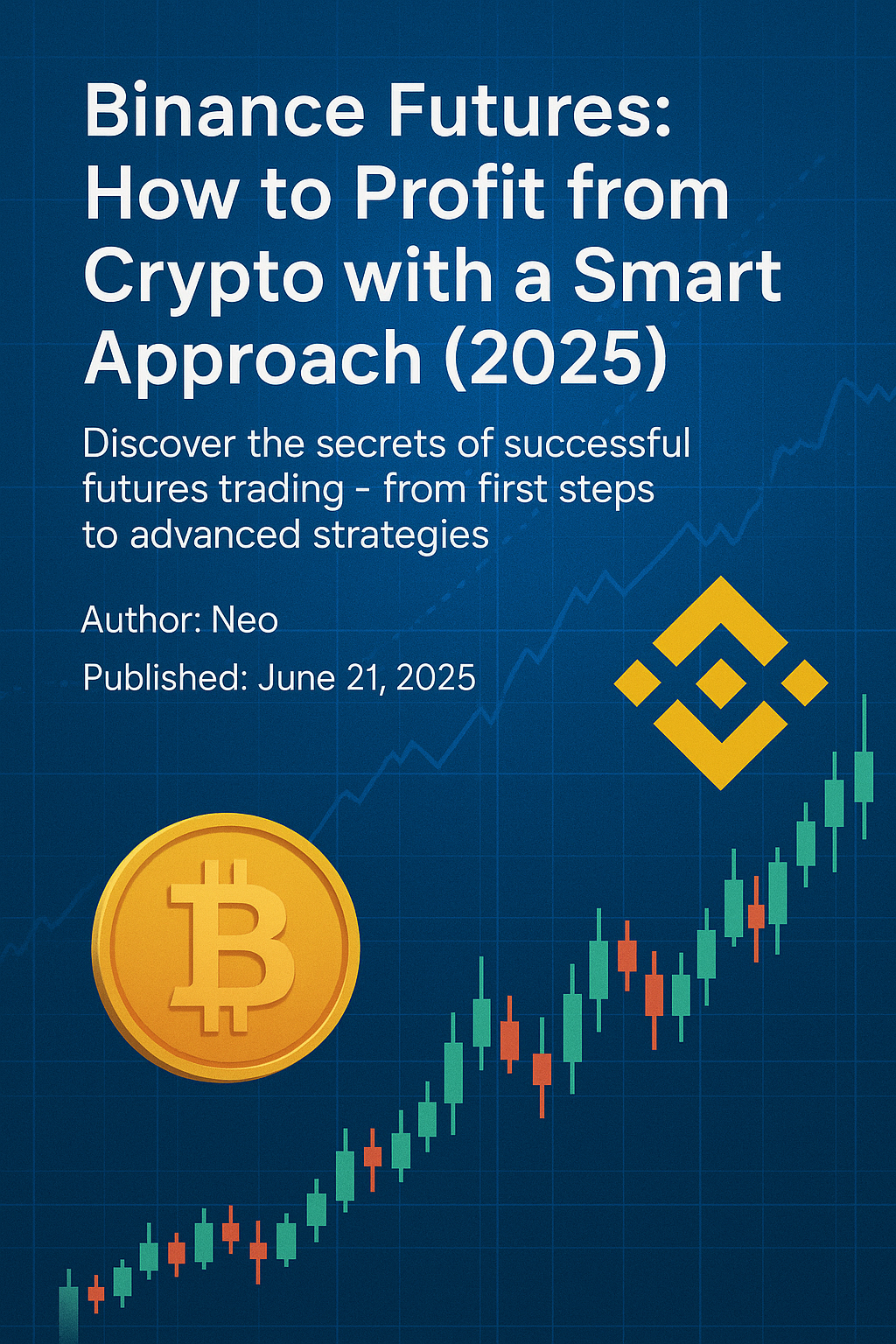Published: June 21, 2025
Imagine being able to make money regardless of whether Bitcoin's price rises or falls. Sounds too good to be true? Welcome to the world of Binance Futures trading - a platform that enables exactly that, but only for those who know what they're doing.
With daily trading volume exceeding $58 billion, Binance Futures has become an arena where fortunes are made and lost every single day. But here's the truth no one will tell you: 95% of traders lose money. Why? Because they enter without a plan, without knowledge, and respect for risk.
This article isn't another "get rich quick" guide. It's a brutally honest look at what it takes to succeed in futures trading - with concrete numbers, strategies, and mistakes you must avoid.
What are Binance Futures and Why They're Revolutionary?
Binance Futures allows you to "bet" on the future price of cryptocurrencies without actually owning them. The keyword? Leverage. With 1,000 youcancontrolapositionworth1,000, you can control a position worth 1,000, you can control a position worth
10,000, 50,000,oreven50,000, or even 50,000,oreven
125,000.
Sounds exciting? It is. Dangerous? Absolutely.
Here's why futures are revolutionary:
You can profit in any market direction. Think Bitcoin will fall? Open a short position. Believe in growth? Go long. Market moving sideways? There are strategies for that too.
Liquidity is incredible. Unlike some altcoins, where you might wait hours to sell, on Binance Futures, you can close a million-dollar position in seconds.
Costs are minimal. Fees start at just 0.000% for maker orders - that's practically free.
But here's where it gets interesting...
The Dark Side of Leverage: Why Most People Lose Everything
Peter, a 28-year-old IT professional from London, thought he'd found a goldmine. He invested 2,500 in Bitcoin futures with 50x leverage. In the first week, he earned $ 2,500 in Bitcoin futures using 50x leverage. In the first week, he earned $ 2,500 in Bitcoin futures using 50x leverage.Inthefirstweek,hemade
3,750. "This is easy," he thought.
A month later, his account was at zero.
What happened? Leverage is a double-edged sword. While it amplifies profits, it equally amplifies losses. With 50x leverage, a price drop of just 2% means complete loss of your capital.
Here's the math that will sober you up:
•10x leverage: 10% drop = you lose everything
•25x leverage: 4% drop = you lose everything
•50x leverage: 2% drop = you lose everything
•125x leverage: 0.8% drop = you lose everything
Bitcoin can drop 10% in a single day. Ethereum 15%. Altcoins? They can halve overnight.
The 2% Rule: The Only Strategy That Works Long-Term
Here's the secret used by professional traders: Never risk more than 2% of your capital per trade.
Sounds boring? Maybe. But here's why it works:
With the 2% rule, you'd need to make 50 consecutive losing trades to lose all your money. That's statistically almost impossible, even for the worst traders.
Practical example:
•You have $10,000 in your account
•2% = $200 maximum risk per trade
•Set stop-loss at $20 per contract
•You can buy a maximum of 10 contracts
Even with 20 consecutive losses (which is already extreme), you'd only lose 33% of capital. With the traditional "all or nothing" approach, one bad day can cost you everything.
Strategies That Work (Tested in Practice)
1. Swing Trading for Beginners
What it is: Holding positions from several days to several weeks, focusing on larger market moves.
Why it works: You don't need to stare at screens 24/7, less stress, and bigger profits per trade.
Concrete strategy:
•Use daily charts
•Look for clear trends (Bitcoin above 20-day moving average = bullish)
•Enter on pullbacks (temporary drops in trend)
•Stop-loss 3% below entry point
•Target: 6-9% profit (risk-reward 1:2 or 1:3)
2. DCA (Dollar-Cost Averaging) for Long-Term
What it is: Regular investment of a fixed amount regardless of price.
Example: Instead of investing 2,500atonce,invest2,500 at once, invest 2,500atonce,invest
250 weekly for 10 weeks.
Advantages: Reduces volatility impact, eliminates need for market "timing."
3. Trend Following for Advanced Traders
What it is: Identifying and following long-term trends.
Entry signals:
•Golden Cross: 50-day moving average crosses above 200-day moving average
•RSI between 40-60 (not overvalued)
•Volume increases with price
How Much Money Do You Need to Start?
Here's the brutally honest answer:
Absolute minimum: 2,000−4,000∗∗. Recommended:∗∗2,000-4,000 **Recommended:** 2,000−4,000∗∗Recommended:∗∗
10,000-20,000
Optimal: $40,000+
Why so much? Because with smaller amounts, the attempt at rapid growth often leads to taking excessive risks. With 800 and the 2800 and the 2% rule, you risk only 800 and the 216 per trade - that's not enough for significant profits, so people start breaking rules.
Biggest Mistakes You Must Avoid
1. FOMO (Fear of Missing Out)
"Everyone's talking about this coin, I must buy NOW!" - recipe for disaster.
2. Revenge Trading
Lost money? Attempting quick recovery through more aggressive trading usually ends in even bigger losses.
3. Ignoring Funding Costs
Futures positions cost every 8 hours. These costs accumulate and can "eat" your profit.
4. Trading Without a Plan
Entering a position without a clear stop-loss and take-profit is gambling, not trading.
Psychology: Your Biggest Enemy is Yourself
Mark had a perfect strategy. Backtesting showed a 70% success rate. But in practice? He was losing money.
The problem? Emotions.
When trading went well, he became greedy and increased his positions. When it went badly, he panicked and closed positions early. The strategy was good, but the execution was catastrophic.
Solution: Automation. Set stop-loss and take-profit orders in advance. Remove emotions from the equation.
Concrete Plan for Beginners (Step by Step)
Weeks 1-4: Education
•Study Binance Futures documentation
•Learn to read charts
•Understand margin, leverage, and funding rate
Week 5-12: Demo Trading
•Use Binance Testnet (virtual money)
•Test strategies
•Keep a trading journal
Month 4+: Real Money
•Start with $2,000-4,000
•Maximum 2-5x leverage
•Focus on Bitcoin and Ethereum
•1-2% risk per trade
Tools That Will Make Your Life Easier
TradingView: Best charts and technical analysis
CoinGlass: Futures market data, long/short ratios
Fear & Greed Index: Market sentiment gauge
Binance mobile app: Backup for emergencies
The Truth About Trading "Gurus"
You see ads: "I made a million dollars in a month!" Here's the truth:
1. Survivorship bias: You only see those who succeeded, not the thousands who failed
2. Cherry picking: They show best results, hide losses
3. Fake screenshots: Photoshop works wonders
Real professional traders rarely brag on social media. They're too busy making money.
The Future of Futures Trading
The crypto market is maturing. Institutional investors are entering en masse. Regulation is becoming clearer. This means:
•Lower volatility (good for stability, evil for quick profits)
•Higher liquidity (easier entry/exit from positions)
•Better tools (AI, quantitative strategies)
•Stricter regulation (more security, less "wild west")
Key Factors to Watch Out For
Market Factors
Macroeconomic conditions are having an increasingly significant impact on crypto markets. Interest rates, inflation, geopolitical events, and central bank monetary policy can significantly affect cryptocurrency prices.
Regulatory news can cause significant price fluctuations in a short period. Positive regulatory news, like Bitcoin ETF approvals, can lead to substantial price increases. Negative news can cause sharp sell-offs.
Institutional adoption is becoming an increasingly important factor. When large corporations announce their purchases of Bitcoin, it often leads to significant price increases.
Technical Factors
Volatility can change dramatically in short periods. During calm market conditions, daily fluctuations may be relatively small. Conversely, during periods of high volatility, even small positions can result in significant profits or losses.
Liquidity can vary significantly between different instruments and during other times of day. Bitcoin and Ethereum typically maintain good 24/7 liquidity, but altcoins may exhibit significant variations in liquidity.
Platform Factors
Funding costs can accumulate significantly over time, especially for long-term positions. Funding rate can be positive or negative, depending on market sentiment.
Margin requirements can change based on market volatility and platform policies. During periods of high volatility, Binance may increase margin requirements for specific instruments.
Conclusion: Your Path to Success
Binance Futures trading isn't gambling - it's a skill. Like any skill, it requires time, practice, and patience to develop.
Key messages:
•Start with education, not money
•Use the 2% rule religiously
•Emotions are your biggest enemy
•Consistency beats spectacular results
There are no magic formulas or secret strategies. There's only discipline, risk management, and continuous learning.
Are you ready to start? Great. But remember - in this game, those who rush usually end up with empty pockets. Those who are patient and disciplined? They build wealth that lasts.


